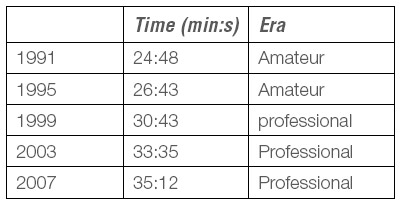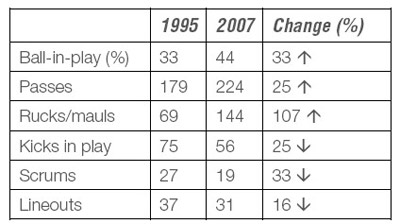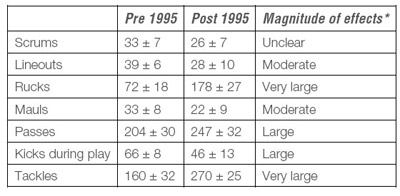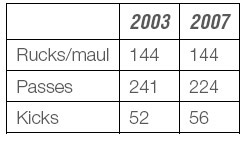To prepare physically for rugby there are basic training principles that need to be understood and adhered to.
Perhaps the most fundamental aspect of training for rugby is the “principle of specificity” which states that training adaptations arising from training are specific to the type of training stimulus.
It follows that the type of training must be structured and planned in accordance with the requirements of the game and demands of the playing position. In some sports this is rather easy, as all the competitors in the team are faced with similar demands.
In rugby, this is not so. Consider that the primary task of the forwards is to wrestle and compete physically for the ball, while the backline players are required to be able to run fast with the ball while avoiding being tackled.
Forwards spend 12 to 13% of the total match time performing high-intensity work, in contrast to the 4.5% of the match time of the backline players.
The “game-within-a-game” in rugby requires that players have different physical characteristics so that they can do their job and fulfil the requirements of the team to the best of their ability.
Therefore to apply the “principle of specificity” in rugby it is important that the physical demands of the game are understood, so that training can be prepared specifically to induce changes and adaptations in accordance with the requirements of the different playing positions.
However, rugby is a game in which the laws are evaluated and changed regularly in an attempt to make the game safer, while also making it faster and more attractive for spectators. This confounds the understanding of the demands of the different playing positions and therefore the way that players need to prepare for matches, because the demands on the players change as the laws change.
This was particularly noticeable coinciding with the onset of professionalism in rugby in 1995. It was also noticeable following the introduction of the Experimental Law Variations (ELV) in the Super 14 in 2008.
The demands of the changing game
The laws of rugby have changed more frequently than the laws of any other comparable sport. Many of the law changes were designed to reduce the risk of injury, but others were designed to make the game more appealing to spectators.
In accordance with this, the goal was to make the game faster, with more tries being scored.
Following the onset of professionalism in 1995, the ball is in play for almost 10 minutes more at the elite level. This is shown clearly in Table 1 where the average ball-in-play times at the World Cup tournaments are shown (amateur era – 1991 and 1995, versus professional era 1999, 2003 and 2007).
This has resulted in different physical demands for both forwards and backline players.
Table 1: Summary of average time of ball in play at the World Cup tournaments (1991-2007) Time (min:s) Era
While the changing laws may, according to some observers, make the game a better spectacle, this always has to be weighed up against the risk of injury.
For example, during the 1993-1994 season, there was an injury episode every 3.4 matches compared to an injury episode every 2.0 matches in 1997-1998.
These changing demands require a refined development of the characteristics comprising the fitness profile of a player.
A summary of studies done over 10 years ago showed that the intensive efforts during a match lasted for five to 15 seconds with less than 40 seconds of recovery between each
bout of match play.
These data however may not accurately reflect the demands of the game at present.
A survey of the earlier studies, particularly from a comparative perspective, can be a little confusing because there is no consistency in the variables measured, and the definitions used to describe the various activities.
Furthermore, the published data have not always included the degree of measurement error. These factors limit the use of the already published data for comparative purposes.
Perhaps the best source of comparative data to illustrate how the game has changed is the data collected from the World Cup tournaments.
As the data are collected by one body (the International Rugby Board, or IRB), it may be assumed that there is some degree of consistency in the data collection. Accordingly, using the data of the World Cup played in 1995 (last tournament in the amateur era) versus the 2007 World Cup 2007, it is clear that the changes in the game have been profound.
These are summarised in Table 2: Activities during the games at the 1995 (pre-professionalism) and 2007 World Cup tournaments, 1995 2007 Change (%)
A study done in the 1970s predicted that players cover a total of 5.8 km during a match. This can be compared to about 5.6 km covered by backline players and 4.2 km by forwards.
A more contemporary study on elite English players showed that backline players covered more distance than forwards (6.1 km vs. 5.6 km) during a match. This included more high-intensity running (448 m vs. 298 m; backline players vs. forwards).
The forwards spend more time doing high-intensity activity (nine minutes) than the backline players (three minutes).
A study of the Bledisloe Cup (1972-2004), an annual competition between Australia and New Zealand shows video recordings of 26 matches that were coded, with 17 of these matches being played before the start of professionalism and nine matches played after the transition.
The ball-in-play time increased by about 20% during the study. This translated to five minutes and 54 seconds. This increase in playing time was ascribed to the decrease in the number of scrums and line-outs, which occurred as a result of a change in the laws.
A summary of the average activities are shown below:
Activities for the Bledisloe Cup matches played before 1995 (n = 17) compared to the matches played after the onset of professionalism (1995) (n = 9) (36) Pre 1995 Post 1995 Magnitude of effects*
*data are interpreted using the magnitude of effects
Dynamics of the scrum
The study also reported that the dynamics during the scrum were different in the 1972 and 1974 matches. During this early era the front rows stood more direct and further apart. The loose forwards would often join the scrum coinciding with, or following, the engagement of the two front rows.
From the 1980s the loose forwards bound and pushed before the opposing tight forwards bound. These changes clearly influenced the forces produced prior to contact of the two front rows.
The very large increase in the number of rucks and tackles during the game (pre vs. post 1995) results in a greater impact stress for each player, resulting in varying degrees of muscle damage.
A study has shown that the clinical signs of muscle damage in rugby players are directly proportional to the number of tackles, either delivered or received.
It is logical that these findings also apply to the impact stress, which occurs as a result of rucks and other forms of contact. Another point to consider regarding the increased physical contact is that most of the injuries that occur in rugby are associated with this aspect of play.
Another study that can be used to describe the changing demands of the game compared characteristics of the game before and after the onset of professionalism.
The authors studied prerecorded matches from the Five and Six Nations Championships between 1988 and 2002. The ball was in play 27% of the time before professionalism (1995) compared to 32% of the time after.
This represents a mean time difference of 4 minutes and 45 seconds of play. This study also showed that the frequency of rucks has significantly increased in the post-professional era, thereby giving rise to more phases of play.
Another study also showed that ball-in-play time increased significantly over a five-year period (1999- 2003) when 496 games were analysed in the Six Nations, Tri Nations, European Cup and Super 12 competitions.
The authors concluded that the changes could be mainly attributed to the law changes that were implemented over this period.
Using the data of the 2003 and 2007 Rugby World Cup tournaments it may be concluded that when the game is defined by activity cycles (rucks, mauls, passes and kicks) there is some stability in the game, certainly at the elite level over this 4-year period (Table 4).
Experimental laws variations
The introduction of the experimental laws variations (ELVs) have made the game even faster, with the ball in being play for longer than before. The media have reported on elite players intentionally losing body mass prior to the start of the 2008 season in anticipation of the increased intensity of the game played under the proposed new laws.
Table 4: Summary of activity cycles per match (rucks, mauls, passes and kicks) at the 2003 and 2007 Rugby World Cup tournaments
Although preliminary reports suggest that the players run further during a match, this needs to be confirmed with experimental data.
To summarise, it is clear that the changing laws have resulted in an increased pace of the game, longer duration of activity, and greater amounts of physical contact requiring strength and power.
The game has also evolved to have an increased number of passes, tackles, rucks, tries and ball-in-play time. Overall, these changes have resulted in an increase in the pace of the game and also the amount of physical contact.
This is an extract of Aspects of Physical Conditioning for Rugby as published on SA Rugby. For the full article click here.
Source Aspects of Physical Conditioning for Rugby by Mike I. Lambert; 1MRC/UCT Research Unit for Exercise Science and Sports Medicine, Department of Human Biology, Faculty of Health Sciences, University of Cape Town.
(Health24, August 2011)




 Publications
Publications
 Partners
Partners













